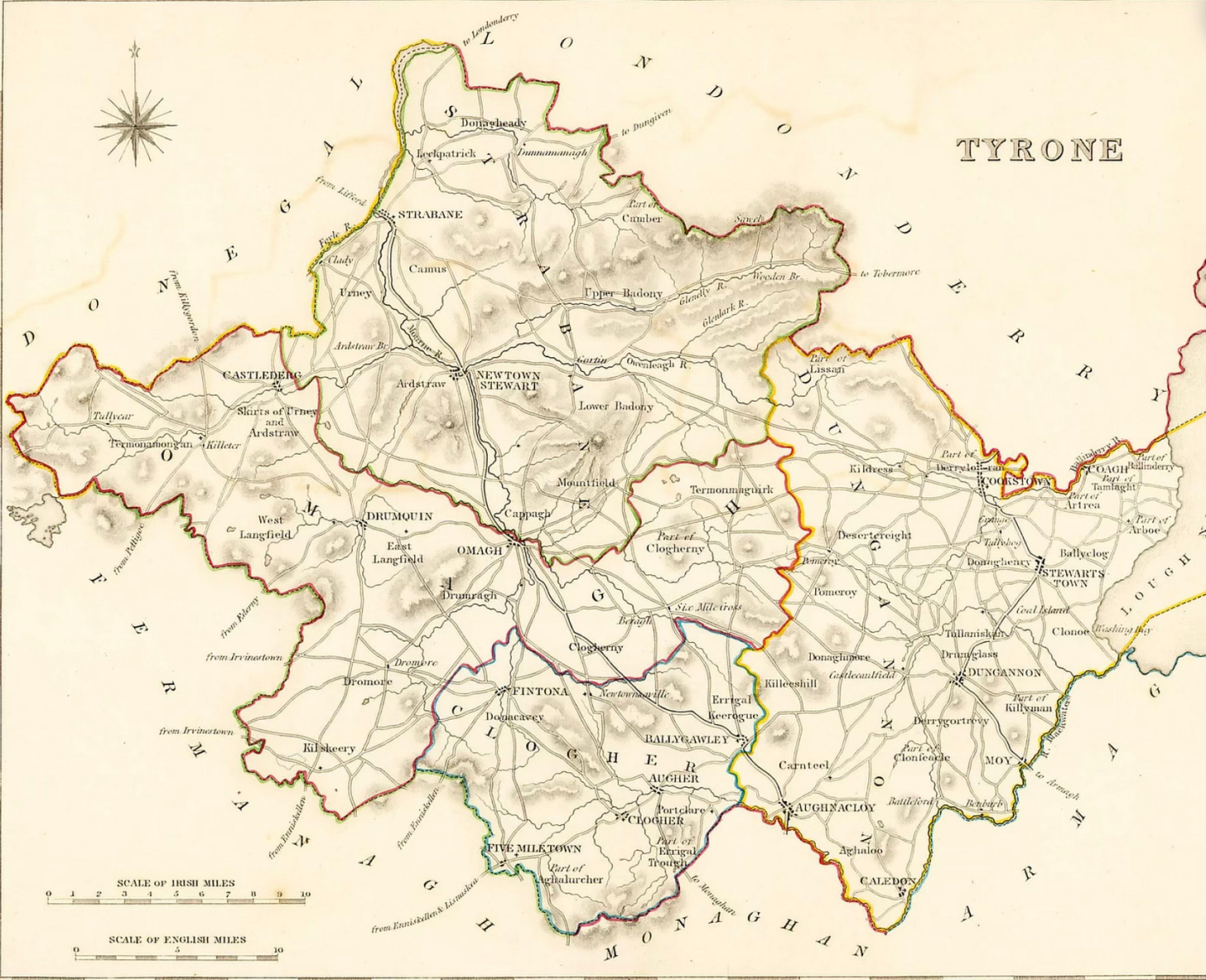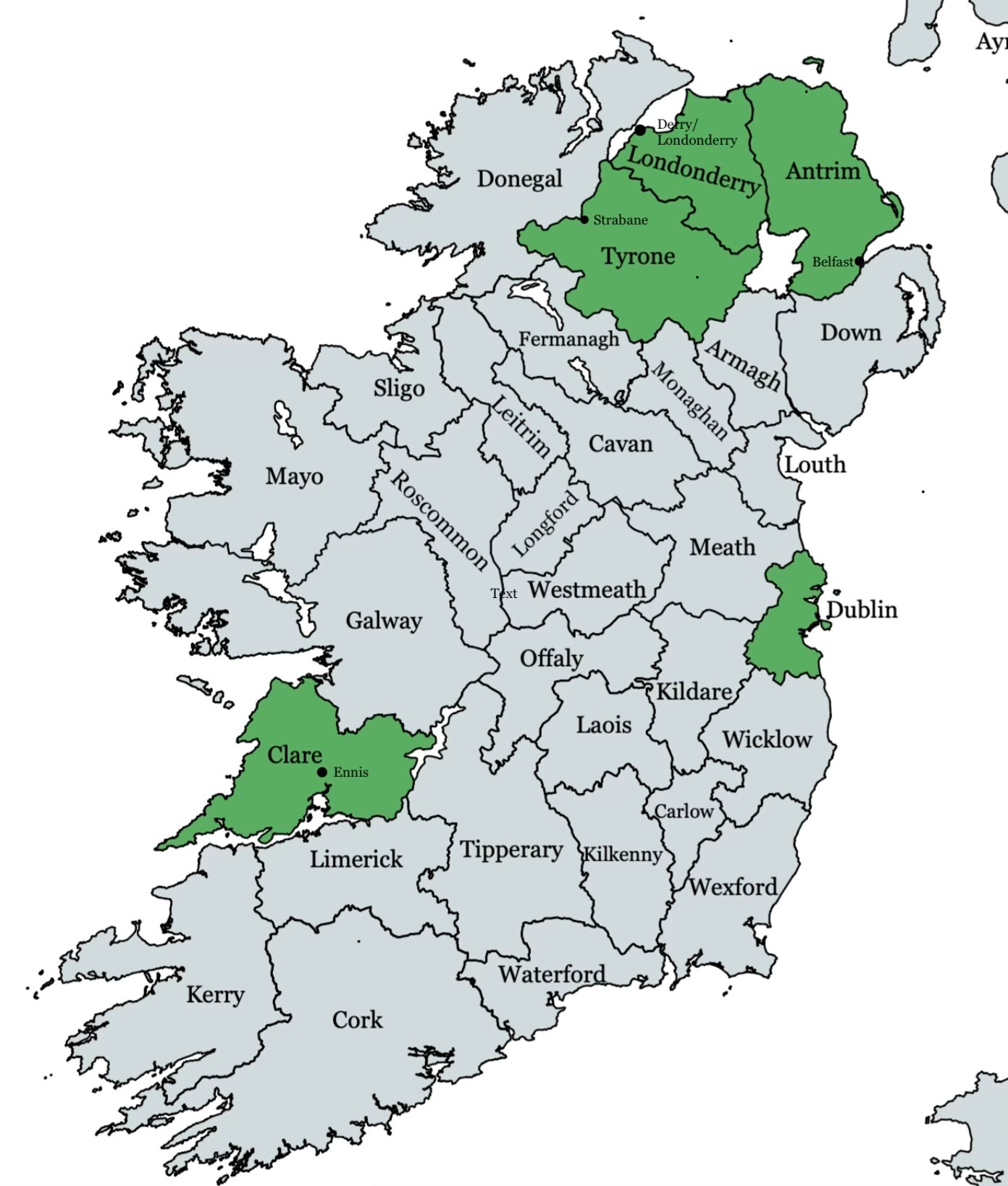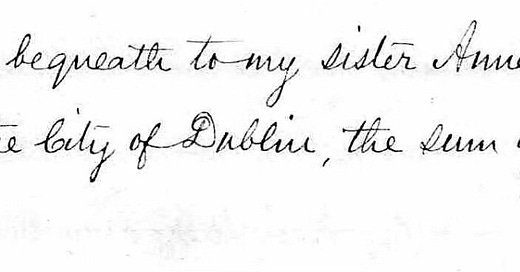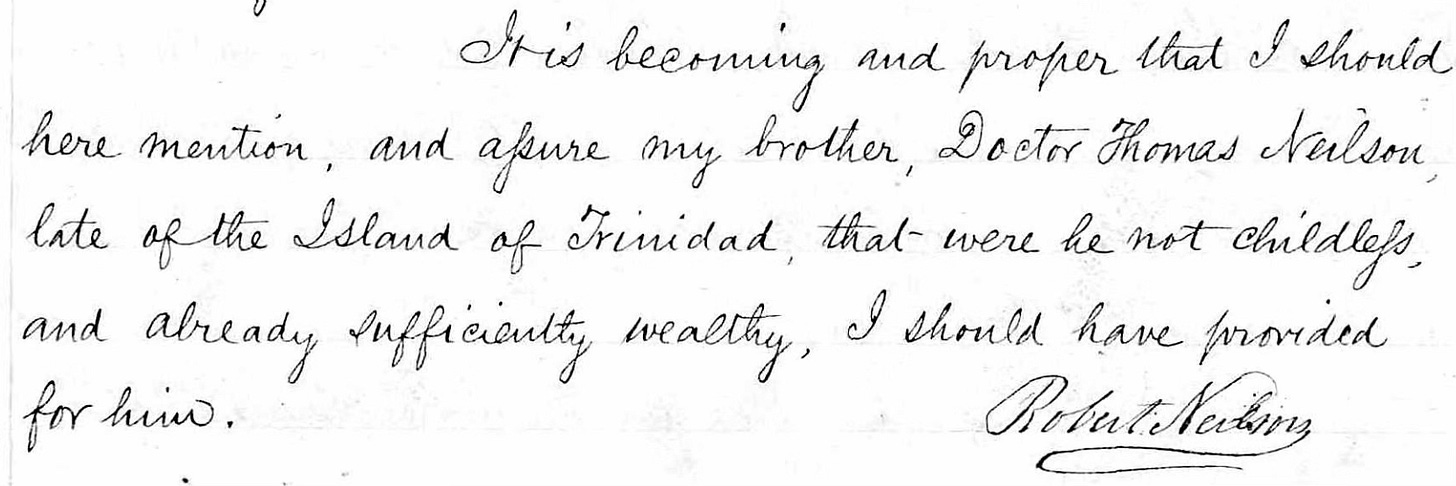“There are two enormous difficulties here. If it is difficult to find and eventually to reconstruct what people did—especially the so-called simple people, with the poor and scanty documentary residue of their lives—it is more difficult to find out what they thought: and even that is less difficult than to know something about what (and how) they believed.”
John Lukacs, A Thread of Years
Anne & Frederick Carolin
In his Last Will & Testament, Robert Neilson made a bequest to his sister Anne:
This gesture—and the manner of its phrasing—may have been partly calculated to reinforce the idea that Robert Neilson was from Dublin, an assertion made a year later in his brief Inquirer obituary. In my last post, I shared some of the fruits of my research into the Carolins of Dublin, concluding with an 1843 announcement of Anne Neilson’s wedding to Frederick Carolin.
My father said to me recently of Robert Neilson, “I was always told he was born in Strabane. That could be wrong.” This was like a lot of information about our family history that I’ve gotten from him over the years: fragmentary. That’s probably how a lot of the information came to him when he was growing up. He lost his parents at an early age, and the adults he was around thereafter may have had bits and pieces of the story. But they didn’t think to tell it all, or perhaps they chose not to.
Dad spent a lot of time with his grandmother, Clara Rosengarten Neilson. The Rosengartens were a family of Jewish descent whose American forbear (Clara’s grandfather George D. Rosengarten) had arrived in Philadelphia from Germany in 1823. George D.’s descendants were lively and accomplished. They built a successful chemical company with a specialty in substances for medical compounding through the 19th century. Most of the family lore my father learned was about them.
One especially vivid story involved a trip by my great grandmother with her son Harry (my grandfather) and daughter Sarah to Germany during the summer of 1914. Late in the trip, war began to look likely on the European continent. Harry Neilson was encouraged to join the Kaiser’s army: he was young—going on 17—but the war would surely be over fast, and he might enjoy some adventure in the meantime. Thankfully—for so many reasons!—my grandfather declined the offer, and the family headed home by way of Britain. The German they spoke and our Jewish heritage were all but invisible by the time I was growing up in the 1960s. The world wars had put German language and culture in a shady spot for some years to come, and a Jewish lineage persecuted by…Napoleon? That seemed very somehow far away.
An Irish ancestor was so much more compelling and of the moment. Yet for some reason, my dad was always pretty vague about Robert Neilson. And though Strabane was occasionally mentioned as the place in Ireland where our family was “from,” there was never any concrete information about why any Neilsons might have been there or what they were doing, much less why they would have left.

Strabane is a large market town at the northwestern edge of County Tyrone. Tyrone is in the north of Ireland, one of nine counties within the ancient province of Ulster. Strabane sits across the Foyle River from Lifford, a smaller town in County Donegal—another of the Ulster nine. The Foyle serves as a natural boundary between Tyrone and Donegal, and in the present era between the United Kingdom and the Republic of Ireland. In the late 18th century, flax grown in the region drove the linen trade, an important source of wealth for local merchants during Robert Neilson’s coming of age.
The Wedding Announcement
At Urney Church, by the Rev. John Conroy, Frederick Carolin, of Talbot-street, Dublin, Esq., to Anne, fourth daughter of the late Wm. Nelson, of Strabane, Esq.
I’ve found nine papers in which the announcement appeared: five in Ulster, three in Dublin, and one in County Clare. The papers in the north were likely to be read by people in Strabane and environs—Anne Neilson’s people. As documented in my last post, the Carolins were a Dublin family. It’s not completely clear why the Clare Journal and Ennis Advertiser carried the item, though there may be some connection to the Vandeleurs, a prominent Clare family that played a role in Edward Carolin’s vitriol assault, also described in my last post.

Despite the variant of Anne’s surname (“Nelson,” instead of “Neilson”), the announcement likely references the sister mentioned in Robert Neilson’s will—to whom he bequeathed $5000. (Attentive readers will recall that in the post on the Dramatis Personae of the will, I suggested that “Carolin” was a variant spelling for “Carolan.” Further research has shown that the reverse is true: “Carolin” is the correct spelling and “Carolan,” the variant.) The groom’s Talbot-street address, confirmed in street directories of the era, and the fact that no other Frederick Carolins appear in Dublin’s newspapers, directories, or church and civil records at that time suggests more strongly that the bride’s name is actually “Neilson,” and that she is the sister of Robert Neilson, late of Philadelphia.
According to most of the announcements Anne is the “fourth daughter of the late William Neilson, of Strabane, Esq.” This information ties her family to Strabane, though it does not necessarily mean that Robert Neilson was born there. By 1843, Robert would have been about 62 years old, assuming he’d been born in 1781, as his obituaries and “Return of a Death” certificate indicate. He was Anne’s much older brother. Here, Brian Darracott, who had first made me aware of Robert Neilson’s will, again supplied me with information that led me to more conclusive confirmation.
In the late 1860s and 1870s, a series of lawsuits wound their way through the chancery and probate courts like Jarndyce and Jarndyce in Bleak House, producing hearings reported on in Irish papers and throwing off information in the process that helped me connect Robert Neilson to Strabane, the locale of his birth. The suits represented the effort of Thomas Neilson Underwood, a nephew of Robert’s, to gain control of the estate left by his other uncle—Robert’s brother, Dr. Thomas Neilson—after the doctor died on December 10, 1866.
In Robert Neilson’s Last Will and Testament, he makes a point of acknowledging his brother: “It is becoming and proper that I should here mention, and assure my brother, Doctor Thomas Neilson, late of the Island of Trinidad, that were he not childless and sufficiently wealthy, I should have provided for him.” Robert presumably had a number of siblings. According to Anne’s wedding announcement, he had at least four sisters in addition to his brother, Thomas. He may simply have been exceptionally close to Anne and Thomas, the only two mentioned in the will. Still, Robert’s mention of Thomas, even though he had no plans to bequeath him any portion of his considerable estate seems odd. He’s going out of his way to “assure” his brother…that he’s not going to be leaving Thomas any portion of his estate. Why?
Dr. Thomas Neilson would die at his Dublin home in Mountjoy Square just ten months after the execution of his brother Robert’s will. From contemporaneous reports on the lawsuits that followed, we know that at the time of his death, Thomas was under the care of Eliza Darracott. She had been his chief support since sometime in 1859. A will executed on August 29, 1860 made Eliza the primary beneficiary of Thomas’s estate. Eliza was, of course, Thomas’s niece because she was the eldest living daughter of Robert Neilson. She had been widowed in 1852 when her husband Thomas Darracott died in Canada shortly after the family relocated there from Trinidad. Eliza had been left with six daughters under the age of 15, according to an 1851 Canadian census document. Robert may have been motivated to give his brother an acknowledgment in the will so as to be sure not to give offense by the omission of even a symbolic bequest (after all, Anne had been remembered). He would have wanted to be sure to cement Thomas’s intention to leave Eliza, who most definitely still needed the money, the bulk of his estate. And Eliza’s motivation—beyond family loyalty and love—in making herself useful to her aged uncle also seems clear.
Thomas Neilson Underwood (1830-1876), Thomas’s nephew, sought to block probate of the 1860 will, in favor of a previous document that, the nephew contended, superseded it. Underwood was a resident of Strabane active in nationalist and tenants’ rights organizations, according to several accounts of the suits and countersuits, many of which appeared in the Tyrone Constitution. The actual details of the suits are convoluted: they involved accusations of “undue influence” by Eliza Darracott, allegations that the 1860 will was executed improperly, and claims and counter-claims of forgery of documents in the case. Underwood’s legal efforts ultimately did not prevail. He was ordered to pay legal costs, and was eventually jailed for a time for failing to do so. Contemporary newspaper reports on the details help to flesh out the family situation of the Neilsons of Strabane.
Thomas Neilson Underwood’s mother Margaret was a sister of Robert and Thomas—and, presumably, of Anne, as well. The document that was the basis of the lawsuits was a deed that under Trinidad law resolved claims that Dr. Neilson and his wife Henrietta would have on their mutually held assets when he departed Trinidad in 1854 and returned to Ireland. The doctor was especially close with his sister Margaret and her son and, it appears, with another sister named Esther. Underwood contended in the legal proceedings that his uncle intended the two women to inherit his estate upon his death. But by the end of 1866 when Dr. Neilson did die, Margaret and Esther were already deceased. According to Underwood, the deed then provided for the transfer of the estate to himself as the doctor’s nephew: Mr. Thomas Neilson Underwood.
These claims were denied by the court—apparently when a judge determined that one of the documents that was the basis of his suit bore a forged signature. Still, Thomas Neilson Underwood will come back into view shortly. For now, we’re concerned with nailing down Strabane as Robert Neilson’s 1781 birthplace. At this point, let’s just note that, in addition to being Dr. Neilson’s nephew, Underwood was a Presbyterian, a life-long resident of Strabane, a barrister who dabbled in poetry and dramas in verse (or, perhaps, a littérateur who dabbled in law), and a founder of the National Brotherhood of St. Patrick, a Republican organization of young men, largely middle class, who professed “fidelity to this principle of nationality” (Moran 1999).
The Patrick Street Graveyard
The Patrick Street Graveyard is located at Patrick and Church Streets in the portion of Strabane northeast of the Mourne River, which bisects the town and joins the River Foyle a mile or two further west. County Donegal sits on the other side of the Foyle, and Lifford, a smaller town than Strabane, sits on that opposite riverbank. The two municipalities are joined in the present day by a small bridge: a lane of cars each way with walkways on either side. On a genealogical website called Roots Ireland, I managed to find an inscription on a stone in the Patrick Street Graveyard transcribed as follows:
HERE LYETH THE BODY OF WILLIAM NEILSON WHO DEPARTED THIS LIFE THE 7TH OF FEBRY 1807 AGED 55 YEARS HE WAS A GOOD AND AN HONEST MAN ALSO HIS INFANT CHILDREN ELIZABETH AND MARY AND HIS INFANT GRANDCHILDREN MARGARETTA HOLMES UNDERWOOD AGED EIGHT MONTHS 13TH MARCH 1821 AND HER LITTLE ANGEL SISTER SLEEPETH HERE THIS DEAR THO DREARY PLACE WAS GOT RAISED BY ESSY NELSON TO THE MEMORY OF HER BELOVED AND RESPECTED FATHER WILLIAM NELSON IN 1826 ALSO MRS MARGARET NELSON WIFE OF THE ABOVE AGED 81 YEARS DIED 9TH FEB 1842.
So…to review. From the will confirmed to be that of Robert Neilson, we have Robert’s siblings, Anne and Thomas. The newspaper wedding announcements of 1843 tell us that Anne’s deceased father William was from Strabane as, presumably, was she. They also tell us that Anne married late in life, as she could have been born no later than November of 1807 if this William Neilson was her father. A notice in the September 30, 1885 edition of the Dublin Daily Express reports that “Anne, widow of the late Frederick Carolin, solicitor, Talbot street” died on September 29, so Anne must have lived to about 78 years of age.
From the details of the chancery and probate suits argued through the late 1860s and -70s, we know that Robert’s brother, Dr. Thomas Neilson, went to live in Trinidad in 1814. He married a woman named Henrietta Geoffry, and when he left Trinidad in 1854, they seem to have divided their community property under a document that became the subject of suits and countersuits by his nephew Thomas Neilson Underwood and his niece Eliza Darracott (Robert Neilson’s daughter). Based on the information from the lawsuits, we also can add Margaret and Esther to the list of Neilson siblings. We learn, too, that Margaret’s married name was Underwood, and that her son, Thomas Neilson Underwood, was a resident of Strabane.
The gravestone inscription links to both Neilsons and Underwoods and puts the Neilson family in Strabane, their parents named William (c. 1752-1807) and Margaret (c.1761-1842). William and Margaret evidently had two daughters who died in infancy: Mary and Elizabeth. Another daughter who survived into adulthood, Margaret Neilson Underwood, experienced similar misfortune (“Margaretta Holmes Underwood aged eight months 13th March 1821 and her little angel sister”). Some of the information from the lawsuits regarding Margaret and Esther is confirmed and elaborated upon by names on the gravestone inscription: “Margaretta” is evidently the name of one of Margaret’s children who died in infancy, and Margaret is named after her mother; while Esther (“Essy”) appears to have been the individual who arranged for the stone.
Armed with this information, and in particular, after finding the various place names on a map, I discovered a transcription of a church marriage record from Raphoe in County Donegal for William Nelson [sic] and Margaret Perry on May 15, 1780. The groom’s given address was “Camus,” a townland included the district of Strabane along with the Patrick Street Graveyard. If this is, as I suspect, the wedding of Robert Neilson’s parents, it aligns with the year of his birth as given in his two Philadelphia obituaries 86 years later: 1781. It suggests also that Robert may have been the eldest of his siblings.
At some point, I’ll need to visit Strabane and its environs to see the inscription in the Patrick Street Graveyard for myself, as well as the transcriptions of the church record of William and Margaret Neilson’s 1780 wedding. There are a handful of other bits of transcribed data I’ll need to verify, too.
I close here having established to a reasonable degree of certainty—absent, of course a birth or baptismal record for the man himself—that Robert Neilson’s family of origin was based in and around Strabane in County Tyrone. Taken together, these findings help to resolve the question of where Robert Neilson was likely born. We can now address questions related to his family’s activities in County Tyrone, his religion, and his decision to leave home.
In the coming sequence of posts, I’ll be looking at additional details that may frame Robert Neilson’s world view and setting them against the historical background of Ireland in the late-18th and early 19th centuries. And I’ll introduce some information that will raise new questions.
Sources
Belfast Commercial Chronicle. “Married.” Belfast Commercial Chronicle, May 29, 1843. https://www.findmypast.com/image-share/7765d607-129c-4076-b364-7544cb4723c8?showBreadcrumbs=true&parentId=.
Belfast News-Letter. “Married.” Belfast News-Letter, May 30, 1843. https://www.findmypast.com/image-share/91d0245e-efef-481b-bde4-a180adbbfc98.
“Census: Saltfleet, Wentworth County, Ontario, Canada .” 1851 Canadian Census. Government of Canada, 1851.
Clare Journal, and Ennis Advertiser. “Marriages.” Clare Journal, and Ennis Advertiser, May 29, 1843. https://www.findmypast.com/image-share/99673a83-2762-4db3-b550-37df5c433719.
Dublin Daily Express. “Deaths.” Dublin Daily Express, September 30, 1885. https://www.findmypast.com/image-share/c9803884-d1d0-4ab7-afd7-e41c3ae52323?showBreadcrumbs=true&parentId=.
Dublin Evening Mail. “Court of Probate: Darracott v. Underwood.” Dublin Evening Mail, February 19, 1869. https://www.findmypast.com/image-share/d5032914-0e62-4b65-b64d-21ee65829a27?showBreadcrumbs=true&parentId=.
Dublin Evening Post. “Court of Chancery: Thomas Neilson Underwood v. Eliza Darracott, and others.” Dublin Evening Post, August 7, 1869. https://www.findmypast.com/image-share/8bcd2b8c-10e1-4223-b702-d9eb4968c58e?showBreadcrumbs=true&parentId=.
Dublin Monitor. “Marriages.” Dublin Monitor, May 26, 1843. https://www.findmypast.com/image-share/ff35dee9-43c5-4017-9a25-60f0da794e64.
Dublin Weekly Register. “Marriages.” Dublin Weekly Register, May 27, 1843. https://www.findmypast.com/image-share/8e58d8a8-c325-47bc-a39d-bfc013c810b5.
Etsy.com. “County Tyrone--1937--Antique Irish Map.” Etsy.com. Accessed March 9, 2024. https://www.etsy.com/ca/listing/534276534/county-tyrone-ireland-1837-antique-irish.
Londonderry Standard. “Married.” Londonderry Standard, May 24, 1843. https://www.findmypast.com/image-share/95f9824a-0362-4659-8eca-db06d8ed15de.
Lukacs, John. A Thread of Years. New Haven & London: Yale University Press, 1998.
Moran, Gerard. “The National Brotherhood of St. Patrick in Britain in the 1860s.” Irish Studies Review Vol. 7, no. 3 (1999): 325-336. https://www.tandfonline.com/doi/abs/10.1080/09670889908455643.
Neilson, Robert. Robert Neilson, Last Will & Testament, February 19, 1866.
Northern Whig. “Married.” Northern Whig, May 25, 1843. https://www.findmypast.com/image-share/9ff474b5-f47b-4819-a27d-1ef269942af6.
Return of a Death in The City of Philadelphia: Physician’s Certificate. Ancestry.com, accessed November 21, 2023. https://www.ancestry.com/mediaui-viewer/tree/32519973/person/19470221183/media/466cc8af-9984-48d2-a1f4-303e37eda33c.
RootsIreland.ie. “Church Marriage Record for William Nelson and Margaret Perry.” RootsIreland.ie, May 15, 1780. https://rootsireland.ie/ifhf/view_detail.php?recordid=209754&type=mch&recordCentre=donegal&page=1&n=1&backLink=quis.php&sc=0.
RootsIreland.ie. “Gravestone Inscription Record for William Neilson.” RootsIreland.ie, February 7, 1807. http://ifhf.rootsireland.ie/view_detail.php?recordid=94755&type=gr&recordCentre=tyronefermanagh&page=1&n=1&backLink=quis.php&sc=0.
Tyrone Constitution. “Court of Probate: Darracott v. Underwood.” Tyrone Constitution, September 24, 1869. https://www.findmypast.com/image-share/2daa2530-dea3-4ee2-b8b5-353e2ffbdd77?showBreadcrumbs=true&parentId=.
Tyrone Constitution. “Rolls Court: Underwood v. Darracott.” Tyrone Constitution, June 7, 1872. https://www.findmypast.com/image-share/3cea0c4c-2b49-45c6-87b9-fd91dd4bcaaa?showBreadcrumbs=true&parentId=.
Tyrone Constitution. “Rolls Court: The Case of Underwood v. Darracott Was Resumed.” Tyrone Constitution, June 7, 1872. https://www.findmypast.com/image-share/eb4e2c73-08f5-4e9f-bcd6-632482f8aa89?showBreadcrumbs=true&parentId=.
Tyrone Constitution. “Rolls Court.” Tyrone Constitution, December 19, 1873. https://www.findmypast.co.uk/image-share/4da5eb6d-652a-4d95-859c-837af3f30164.
Ulster Examiner and Northern Star. “Death of Mr. Thomas Nielson Underwood.” Ulster Examiner and Northern Star, October 11, 1876. https://www.findmypast.com/image-share/3b88dab6-7648-47fd-bc46-619b7bdc7f0b.
Ulster Examiner and Northstar. “The Late Thomas Neilson Underwood, Esq., BI.” Ulster Examiner and Northstar, October 14, 1876. https://www.findmypast.com/image-share/6966c112-92c4-4c1c-9b34-703432460dd0.
Vindicator. “Married.” Vindicator, May 31, 1843. https://www.findmypast.com/image-share/35f2ce0f-ccb0-46ba-a201-2ee8337cc39d.
Visit Derry. “Patrick Street Graveyard, Strabane.” Visit Derry. Accessed March 4, 2024. https://www.visitderry.com/things-to-do/patrick-street-graveyard-strabane-p836371.
Weekly Freeman’s Journal. “Marriages.” Weekly Freeman’s Journal, May 27, 1843. https://www.findmypast.com/image-share/a49a2d0f-7ed1-409e-bbb2-e5ed00dfc49b.








Hi Jamie, just a note to say how much I appreciated these posts. I'm a Tyrone native and currently working on a walking tour of Dublin city and am featuring Thomas Neilson and Thomas Neilson Underwood as one of the stops. Your work here has been extremely helpful!
Hello Jamie, I was wondering if you could help us place an Anne Goodall (born Neilson) into this family tree. Me and a few other university students have chosen a project investigating her wedding dress and her family ties to slave plantations in Trinidad and Tobago. All we know is that she was born in 1807, Trinidad, married Nicholas Goodall in 1828, Wexford, Ireland and died in 1890, Bristol, Gloucestershire. Thank you so much!!
- Anya:))